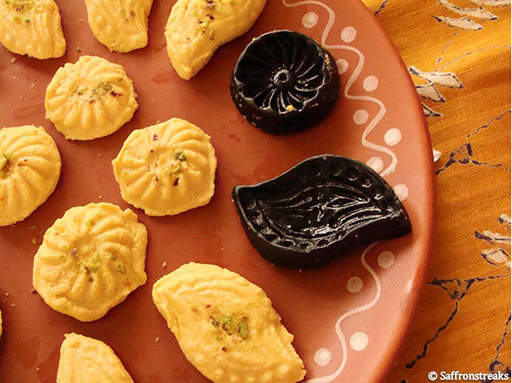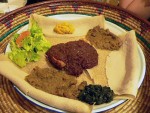In this guest post, Sukanya of the food and travel blog Saffronstreaks shares with us the recipe for a favorite Bengali milk-based sweet from Kolkata (Calcutta): aam sandesh, or Indian fudge infused with mango. Of course, this “fudge” is not made with chocolate but with cottage-cheese-like chhana (also spelled chenna); the translation stems more from the dish’s texture. For more on milk-based treats from India, check out our Delhi sweets section.

Bengalis’ love for sweets is a well-known affair, and sandesh (“fudge”) is one they particularly adore. The great Bengali luncheon always ends on a sweet note,
and it doesn’t stop there; it continues with late-afternoon tea and dinner as well. Life revolves around tales of sweets from birth, marriage until death, and haunting memories laden with nostalgia, weaving stories and unfolding the secrets of sandesh making, a 150-year-old culinary art that remains the forte of a selected few.
Unlike in the West, sweets in India, and especially in Kolkata, are made with chhana, a type of cheese. The process is very similar to ricotta, in which milk is first boiled and then curdled with the help of an acidifying agent. It’s then left to sit for hours, until the whey has completely separated and drained, leaving behind pure chhana cottage cheese ready to be molded into fudge of different shapes and flavors: sandesh.
The name of sandesh often reflects its shape, texture, and flavor; indicates the season; and sometimes even portrays the psyche of society. For instance, shankh (conch shell) and maach (fish) are the two most common shapes, whereas pistachio, saffron, almond, rose, nolen gur (date molasses) in winter and mango in summer are popular flavors. Sometimes the sandesh caught the poetic fancies of its creator, so we have pranharaand manohara (captivator of soul and heart, respectively), whereas nayantara (star of the eye) and its charismatic magic spell led to the creation of abar khabo (I’ll have another). One more variety that deserves special mention is jalbhara talshansh sandesh (with a filling of rose syrup inside), created by S.K. Modak around 1820, a very renowned sweet maker of that period. When aam (mango) sandesh appears on display at sweet shops, it announces the onset of summer.
Aam sandesh, or Indian “fudge” infused with mango
Preparation time: 30 min.
Cooking time: 20 min.
Serves 6
Milk (full fat): 1 liter
Ripe mango pulp, thickened and sweetened with sugar: 1 cup
(Note: Canned mango pulp will likely already be both; if using fresh sweet mango, strain the pulp, heat if watery, and add sugar to taste.)
Cardamom powder: 1/2 tsp
Souring agent to curdle the milk, like the juice of one lemon or white vinegar (1 Tbsp)
1. Boil the milk, curdle it using the souring agent of your choice, drain the whey. and collect the cheese. See a pictorial description here.
2. Knead the resulting chhana cheese with the heel of your palm for 10 minutes until it become soft and smooth.
3. Warm slightly a nonstick pan and put in the chhana along with the sweetened mango pulp; mix thoroughly and cook on low heat while constantly stirring it.
4. You will notice that it gradually changes its color and texture. When almost done it will become lumpy or doughlike. Quickly remove it then from heat and transfer into a bowl. This is called makha, or ready to be molded.
5. If you are using molds, grease the inside of them slightly with ghee (clarified ghee), sprinkle some topping (I have used finely crushed pistachios) inside, and press the chhana into the molds, smoothing the edges to give each a neat shape. (Note: If you don’t have ghee, melted unsalted butter is fine to use.) Gently take them out of the mold.
6. Repeat the process with the rest of the chhana, or, if not using molds, simply shape them however you desire and sprinkle on your favorite toppings.
7. Serve at room temperature or chilled.
About the author: Sukanya Ghosh writes at Saffronstreaks, a food and travel blog. Besides being a passionate cook and a novice baker, she loves to travel where she can explore and understand a new culture and people through its art, heritage, history, archaeology, food, crafts, and more.










.jpg)

